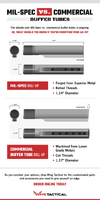I need a common sense answer to this question, so I come to THR. I don't want to get too much into the weeds with tensile strength, type of aluminum alloy, etc.
I'm going to get a RRA Operator stock for my AR. I have one on my other AR and really like it.
RRA gives two options (they only sell the stock as part of a kit, not separately): One kit comes with a Comm tube ($140), and one comes with a Mil-Spec tube ($160). So, $20 difference. They told me they use Comm tubes as their standard. I think because they are cheaper to produce. Here is the link to the two kits (scroll down to see all options):
 www.rockriverarms.com
www.rockriverarms.com
This will be used on a range gun, maybe some occasional competition (but I doubt it.) But I'm not going to war with it.
My other gun with the Comm tube and Operator stock hasn't given me any problems so far. Plus, getting a Comm kit would have both guns being consistent in the tubes they use.
However, I don't want to be penny-wise and pound-foolish to save $20.
Am I GTG with the Comm tube, or is there a compelling PRACTICAL reason to go with Mil-spec? It looks like most companies (like Magpul) make both versions of their stocks, should I ever want to change out.
Remember, talking practical differences only.
Thanks
I'm going to get a RRA Operator stock for my AR. I have one on my other AR and really like it.
RRA gives two options (they only sell the stock as part of a kit, not separately): One kit comes with a Comm tube ($140), and one comes with a Mil-Spec tube ($160). So, $20 difference. They told me they use Comm tubes as their standard. I think because they are cheaper to produce. Here is the link to the two kits (scroll down to see all options):
RRA Operator CAR
Rock River Arms, Inc. offers a complete line of American made, custom built AR15 style rifles.
This will be used on a range gun, maybe some occasional competition (but I doubt it.) But I'm not going to war with it.
My other gun with the Comm tube and Operator stock hasn't given me any problems so far. Plus, getting a Comm kit would have both guns being consistent in the tubes they use.
However, I don't want to be penny-wise and pound-foolish to save $20.
Am I GTG with the Comm tube, or is there a compelling PRACTICAL reason to go with Mil-spec? It looks like most companies (like Magpul) make both versions of their stocks, should I ever want to change out.
Remember, talking practical differences only.
Thanks




